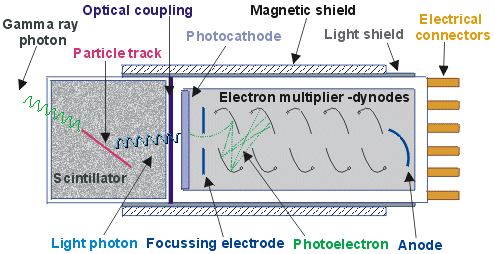The output from the scintillation
crystal is a quantity of light which must be measured and
converted into an electrical signal. Conventionally this is done by a
photomultiplier tube shown here.
|

|
|
-
the light photon strikes a light sensitive layer, the
photocathode, causing it to emit a photoelectron;
-
the photoelectrons are focused electrostatically onto the first
of a series of electron multiplier stages called dynodes;
-
the dynodes emit more electrons than they receive thus the
signal is amplified;
-
the amplifier signal is then collected at the anode and hence
can be measured; and
-
the magnitude of the final signal is proportional to the
scintillator light output, which is proportional to the energy
loss that produced the scintillation.
|
|